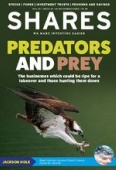Archived article
Please note that tax, investment, pension and ISA rules can change and the information and any views contained in this article may now be inaccurate.
Could BH Macro be the ‘reassuringly expensive’ Stella Artois of hedge fund trusts?

The market regards hedge fund Brevan Howard as one of the leading global macro absolute return investment managers.
Absolute return specialists aim to deliver a positive return to investors regardless of whether markets are rising or falling. They often own a mix of bonds and stocks as well as other asset classes and sometimes look to benefit from the value of assets falling as well as rising (a short/long approach).
Brevan Howard aims to combine rigorous research into the macro-economic backdrop with an uncompromising focus on risk management.
Its BH Macro Fund (BHMG) has a record of outperforming during bear markets and thriving during periods of foreign exchange and interest rate volatility.
During the worst 20 performing months for stocks over the fund’s history, it has delivered positive returns in 17 of them.
TRADING AT A PREMIUM
The fund currently trades at a 14.7% premium to net asset value (NAV). This reflects its outstanding performance with total share price returns over one, three, five and 10 years of 25.5%, 63%, 126.2%, and 131.1% respectively. This compares with comparable returns for the AIC (Association of Investment Companies) hedge fund sector of 3.1%, 44.1%, 45.8% and 108.1%.
As a diversifier to shares and bonds BH Macro offers investors an interesting proposition in mitigating downside risk and delivering impressive returns during periods of stock market stress.
This is at a time when gold’s safe haven credentials are being questioned and fixed income investments look increasingly fragile thanks to rising rates.
The Brevan Howard Master Fund (BHMF) is closed to new investors, so the listed vehicle is the only way to gain exposure. But there are three potential drawbacks that investors need to appreciate.
First, BH Macro charges significantly higher fees than traditional funds and investment trusts. Second, the fund can experience periods of underperformance. Muted foreign exchange and interest rate volatility contributed to the share trading sideways for a considerable portion of the last decade. Third, the underlying positions in the fund can be hard to decipher.
WHAT IS BREVAN HOWARD’S APPROACH?
BH Macro came to the market via an initial public offering (IPO) in 2007 and merged with BH Global (its smaller listed brethren) in 2021 to become the liquid £1.3 billion vehicle it is today. The fund is invested directly into the Brevan Howard Master Fund.
BHMF pursues a multi-trader model that includes a combination of macro directional and macro relative value strategies, with exposures predominantly to global fixed income and foreign exchange markets.
A directional trading approach involves taking a view on the future direction of the market, while relative value strategies typically involve taking long positions in undervalued assets and short positions in overvalued assets, often in the same asset class.
There are peripheral exposures to other areas including stocks, debt and commodities. The way Brevan Howard tends to work is that each portfolio manager is given a strict mandate and an amount of capital with which to trade.
Risk management is key to the firm, and so if a trader successfully generates good returns within their mandate and risk tolerances, over time they are allocated a greater amount of capital. Trades are typically leveraged (borrowing money from brokers to make a portion of the trade), and might typically generate proportionately high returns if the trade works out, though this approach can also exacerbate losses.
Component parts of the fund
MF Core (32%): multi asset class, macro, systematic and relative value trading. Multiple portfolio managers.
Brevan Howard Alpha Strategies (32.5%): multiple portfolio managers fund. Relative value and directional strategies in developed and emerging fixed income and foreign exchange markets.
Brevan Howard AS Macro (9.4%): Single portfolio manager, relative value strategies in developed market interest rates.
Brevan Howard FG Macro (9.7%): Single portfolio manager-multi asset class macro trading.
Brevan Howard MB Macro Master Fund (9.7%): Single portfolio manager, macro/ relative value strategies in Asia-focused interest rate and foreign exchange market.
Brevan Howard Global Volatility Master Fund (6.7%). Thematic Fund, multi-asset class macro, systematic and relative value trading.
BALANCING RISK AND REWARD
Brevan Howard is looking for asymmetry between risk and reward – or in other words looking for situations where the potential for gain is greater than the potential for loss.
This is illustrated by a recent example. In late 2019, in light of slowing economic data, BH was positioned to benefit from potential interest rate cuts by the Federal Reserve. At this time the market was pricing almost no probability of a Fed cut in early 2020, so the trade had good risk/reward asymmetry.
As news about the Covid pandemic started to pick up, BH felt that this would increase the probability of Fed cuts although the market pricing at that time not responded. In March 2020, as the impact of the pandemic became clearer and the Fed enacted 150 basis points of emergency cuts, the fund made significant returns.
As the tables overleaf show, the track record of BH Macro is impressive when compared to both its hedge fund peer group but also versus the three main capital preservation trusts. This outstanding performance has been cited as a justification for its fee structure.
IS IT REASSURINGLY EXPENSIVE?
In August 2021 Stella Artois attempted to capitalise on the surge in consumer demand for trusted brands with the return of its ‘Reassuringly Expensive’ tagline.
At the beginning of 2021 Brevan Howard demanded a doubling in its annual management charges and a return to performance fees, threatening to resign from managing the investment trust if this wasn’t forthcoming.
The fund manager had lowered its fees after shares performed in a lacklustre fashion for several years. Fees were broadly halved by cuts in 2016 and 2017. The dramatic increase in fees was approved a shareholder vote in March 2021, demonstrating the appeal of its robust performance.
As a consequence the fund had an ongoing charge of 2.39% in 2021 according to the AIC – which added up to 3.06% once performance fees were included.
Important information:
These articles are provided by Shares magazine which is published by AJ Bell Media, a part of AJ Bell. Shares is not written by AJ Bell.
Shares is provided for your general information and use and is not a personal recommendation to invest. It is not intended to be relied upon by you in making or not making any investment decisions. The investments referred to in these articles will not be suitable for all investors. If in doubt please seek appropriate independent financial advice.
Investors acting on the information in these articles do so at their own risk and AJ Bell Media and its staff do not accept liability for losses suffered by investors as a result of their investment decisions.
Issue contents
Feature
- Explaining SIPP tax relief: the big details you need to know
- Predators and prey: the businesses which could be ripe for a takeover and those hunting them down
- What high gross margins tell investors about the merits of a business
- The one thing that famous investors Terry Smith and Warren Buffett seek when picking stocks

 magazine
magazine








